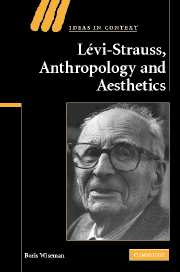Book contents
- Frontmatter
- Contents
- List of illustrations
- Acknowledgements
- Introduction: ethno-aesthetics
- 1 The reconciliation
- 2 Art and the logic of sensible qualities
- 3 The work of art as a system of signs
- 4 Structuralism, Symbolist poetics and abstract art
- 5 The anthropologist as art critic
- 6 Nature, culture, chance
- 7 From myth to music
- 8 Lévi-Strauss's mytho-poem
- Conclusion: between concept and metaphor
- References
- Index
- IDEAS IN CONTEXT
2 - Art and the logic of sensible qualities
Published online by Cambridge University Press: 27 October 2009
- Frontmatter
- Contents
- List of illustrations
- Acknowledgements
- Introduction: ethno-aesthetics
- 1 The reconciliation
- 2 Art and the logic of sensible qualities
- 3 The work of art as a system of signs
- 4 Structuralism, Symbolist poetics and abstract art
- 5 The anthropologist as art critic
- 6 Nature, culture, chance
- 7 From myth to music
- 8 Lévi-Strauss's mytho-poem
- Conclusion: between concept and metaphor
- References
- Index
- IDEAS IN CONTEXT
Summary
To understand Lévi-Strauss's works fully, we need to read them with an eye for the concealed lateral connections that link their different facets, the anthropological and the aesthetic, the philosophical and the poetic, the theoretical and the literary. In the preceding chapter I have shown that Lévi-Strauss's understanding of the nature of aesthetic perception and creation is intimately related to his understanding of the modes of functioning of what he calls pensée sauvage – a ‘wild’ mode of thought common to all human beings, whether ‘primitive’ or not. Although he does not say so explicitly himself, Lévi-Strauss construes art as emerging from the same elemental ‘totalising function’ – an expression of the human impulse to impose order upon chaos – as the various other products of pensée sauvage, such as myth, ritual, classification and totemism. In this connection, I argued that Lévi-Strauss saw art as one of several ‘offspring’ of ‘wild’ thinking and hence as being genealogically related to the others, with whom it shares certain ‘family resemblances’, among them the drive to fulfil the ‘totalising function’, although the ‘totalities’ produced by ‘wild’ thinking are never complete and are in perpetual readjustment. In this chapter, I will continue to explore the interconnections that link Lévi-Strauss's anthropological theories and his aesthetic theories around the concept of pensée sauvage, a connection that is fundamental to Lévi-Strauss's system of thought.
- Type
- Chapter
- Information
- Levi-Strauss, Anthropology, and Aesthetics , pp. 58 - 79Publisher: Cambridge University PressPrint publication year: 2007



